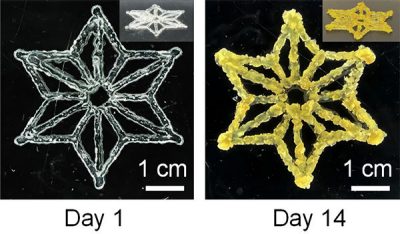
Synthetic Biology, Genetic Engineering, and 3D Printing Develops Customizable Living Materials
May 8, 2024| |
Chinese researchers are using cells to produce materials that have the ability to grow, repair themselves, and respond to their surroundings. Their findings may have potential applications in biomanufacturing and sustainable construction.
Previous studies have been using bacterial and fungal cells to produce engineered living materials. Recently, plant cells have gained interest due to their usage in engineered plant living materials (EPLMs). However, the materials based on plant cells have basic structures and limited functionality.
To address this issue, scientists from various institutions developed complex-shaped EPLMs that have genetically engineered plant cells, which can be customized based on the preferred capabilities and behaviors. The team combined tobacco cells with biocompatible hydrogel microparticles (HMPs) with Agrobacterium tumefaciens, which is a bacterium utilized for transferring DNA segments into plant genomes.
The mixture was then 3D printed, cured with blue light, and washed with antibiotics. After a few weeks, the tobacco plant cells grew, replicated, and produced proteins instructed by the transferred DNA. The created red or yellow plant pigments and green fluorescent proteins are valued as dietary supplements and natural colorants.
Read the press release of the American Chemical Society for more information.
| |
You might also like:
- Scientists Produce Synthetic Cells Similar in Function to Living Cells
- Researchers Engineer Cell-Like Structure for Photosynthesis
- Researchers Develop Method that can Modify Individual Animal Cell Differently
Biotech Updates is a weekly newsletter of ISAAA, a not-for-profit organization. It is distributed for free to over 22,000 subscribers worldwide to inform them about the key developments in biosciences, especially in biotechnology. Your support will help us in our mission to feed the world with knowledge. You can help by donating as little as $10.
-
See more articles:
-
Plant
- Plant's Drought Stress Hormone Blocks Spider Mites
- Researchers Pinpoint Gene for Tobacco Resistance Against Chilli Veinal Mottle Virus
- ISAAA Inc. Joins UPLB Devcom's 5th Science Communication Roundtable Discussion
- Scientists Bring CRISPR to the US Senate
- EFSA Releases Assessments of Two GM Maize for Import, Processing, and Food and Feed Uses within EU
-
Health
- Synthetic Biology, Genetic Engineering, and 3D Printing Develops Customizable Living Materials
-
Environment
- Kenya Steps up Efforts in Fight Against Biosafety Misinformation
-
Read the latest: - Biotech Updates (November 26, 2025)
- Gene Editing Supplement (November 26, 2025)
- Gene Drive Supplement (February 22, 2023)
-
Subscribe to BU: - Share
- Tweet

